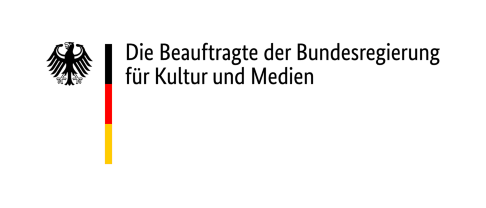Miniaturbiennale II
18.05.–27.10.2024
Frankfurt am Main
Hauptbahnhof
Unter dem Titel Colliding Worlds widmet sich die Miniaturbiennale II der Virtualität von Weltwahrnehmung. Zwölf künstlerische Positionen suchen und erzeugen in der Miniaturwelt des Modellbahnautomatens am Frankfurter Hauptbahnhof Wahrnehmungsverschiebungen und Momente der Irritation inmitten der paradoxen Logik dieses scheinbaren Kleinstadtidylls. Das Fabelhafte, das Ungewohnte und das Unheimliche sickern in die Landschaften rund um die ziellos kreisenden Bahnstrecken ein.
Das Kondensieren von realen Begebenheiten auf kleinstem Raum führt den Versuch der Simulation von Realität ad absurdum und verkehrt sich bei genauer Betrachtung ins Gegenteil. Die einzelnen Situationen, aus denen sich diese Szenerie konstruiert, mögen zwar – kopiert und verkleinert – der Realität entnommen sein, erzeugen aber in ihrer komprimierten und spielerischen Zusammenstellung ein Zerrbild. Lassen sich einige dieser Verzerrungen intuitiv erkennen und benennen, bleiben andere dieser Verzerrungen stumm.
Under the title Colliding Worlds, the Miniaturbiennale II is dedicated to the virtuality of world perception. Twelve artistic positions seek and create shifts in perception and moments of irritation amidst the paradoxical logic of this seemingly small-town idyll in the miniature world of the model railway automat at Frankfurt Central Station. The fabulous, the unfamiliar and the uncanny seep into the landscapes surrounding the aimlessly circling railway tracks.
The condensation of real events in the smallest of spaces reduces the attempt to simulate reality to absurdity and, on closer inspection, turns into the opposite. The individual situations from which this scenery is constructed may be taken from reality – copied and miniaturised – but in their compressed and playful composition they create a distorted image. While some of these distortions can be recognised and named intuitively, others remain mute.
01
Janet Cardiff & George Bures Miller
Go to Bio
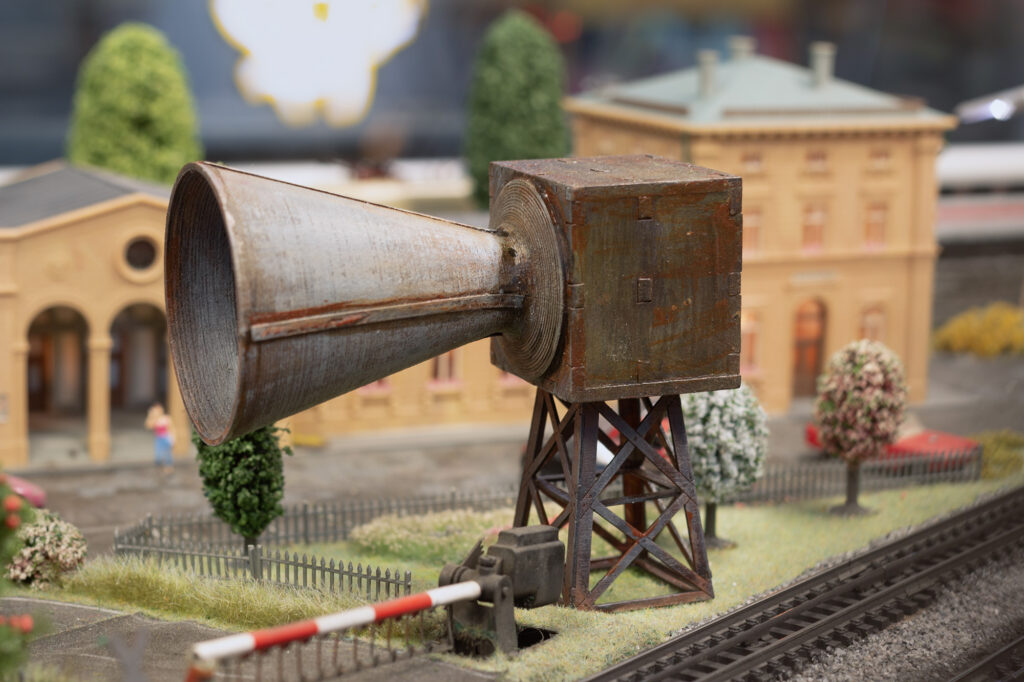
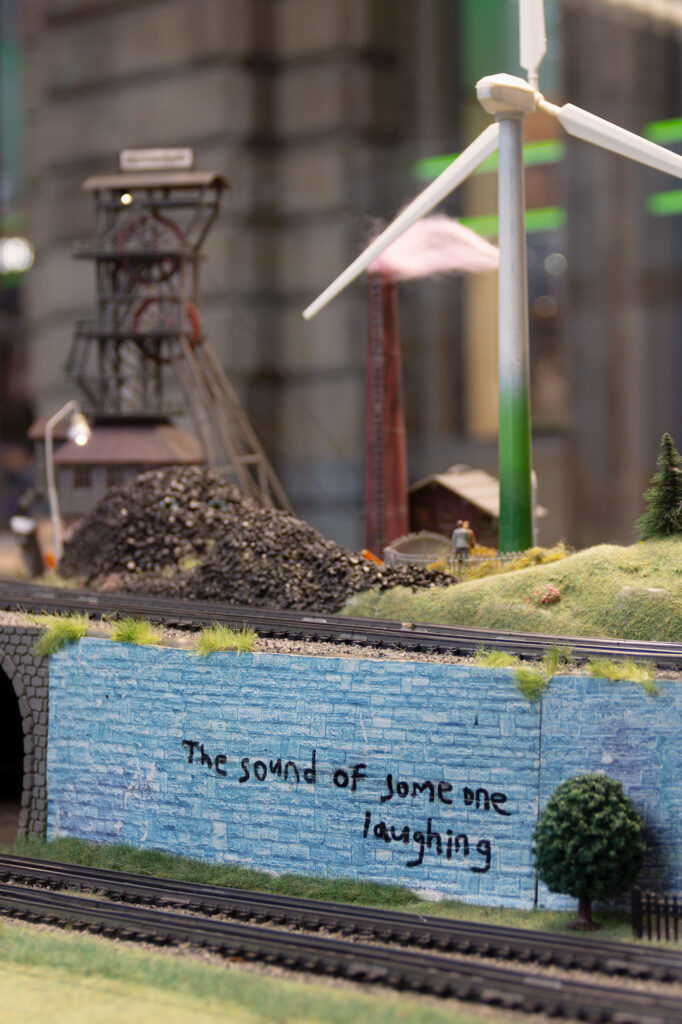
Monument, 2024
Holz und Plastik
The sound of someone laughing, 2024
Pigmentdruck
Die Welt im Glaskasten bildet eine kleine stille Insel im Trubel des Frankfurter Bahnhofs. Trotz der angedeuteten Geschäftigkeit im Inneren dringt kaum ein Ton nach außen. Dieses Paradox greift das kanadische Künstler:innen-Duo Janet Cardiff & George Bures Miller in seinen Beiträgen für die Miniaturbiennale auf, die ebenfalls ganz ohne Geräusche auskommen.
Neben dem Bahnhofsparkplatz der kleinen Stadt ist die Skulptur eines seltsam proportionierten Horn-Lautsprechers platziert. Der verhältnismäßig große Trichter erinnert an eine blecherne Flüstertüte – ein Gerät, das die Ausbreitung von Schall lenkt und damit gesprochene Sprache oder auch Musik über größere Entfernung hörbar macht. Den Fuß der Konstruktion bildet eine Fachwerkstruktur, die an den stählernen Eiffelturm denken lässt. Monument überragt die umstehenden Bäume, Autos und Bewohner:innen der Umgebung: Man stellt sich ein ohrenbetäubendes Getöse vor, das von hier aus über die Platte schallt. Welche Informationen werden wohl mitgeteilt?
Womöglich erklingt ein (stummes) Lachen, das sein Echo oder seinen Ursprung in der Aufschrift The sound of someone laughing an der rückwärtigen Mauer des Bahndamms findet.
Monument, 2024
Wood and plastic
The sound of someone laughing, 2024
Pigment print
The world in the glass box forms a small, quiet island in the hustle and bustle of Frankfurt railway station. Despite the implied hustle and bustle inside, hardly a sound penetrates to the outside. The Canadian artist duo Janet Cardiff & George Bures Miller take up this paradox in their contributions to the Miniaturbiennale, which also manage without any sound at all.
The sculpture of a strangely proportioned horn loudspeaker is placed next to the parking lot at the station of the small town. The relatively large funnel is reminiscent of a tin whispering bag – a device that directs the propagation of sound and thus makes spoken language or music audible over long distances. The base of the construction forms a lattice structure reminiscent of the Eiffel Tower. Monument towers above the surrounding trees, cars and residents: one imagines a deafening roar echoing across the slab from here. What information is being communicated?
Perhaps a (silent) laugh can be heard, which finds its echo or its origin in the inscription The sound of someone laughing on the rear wall of the railroad embankment.
02
FORT
Go to Bio
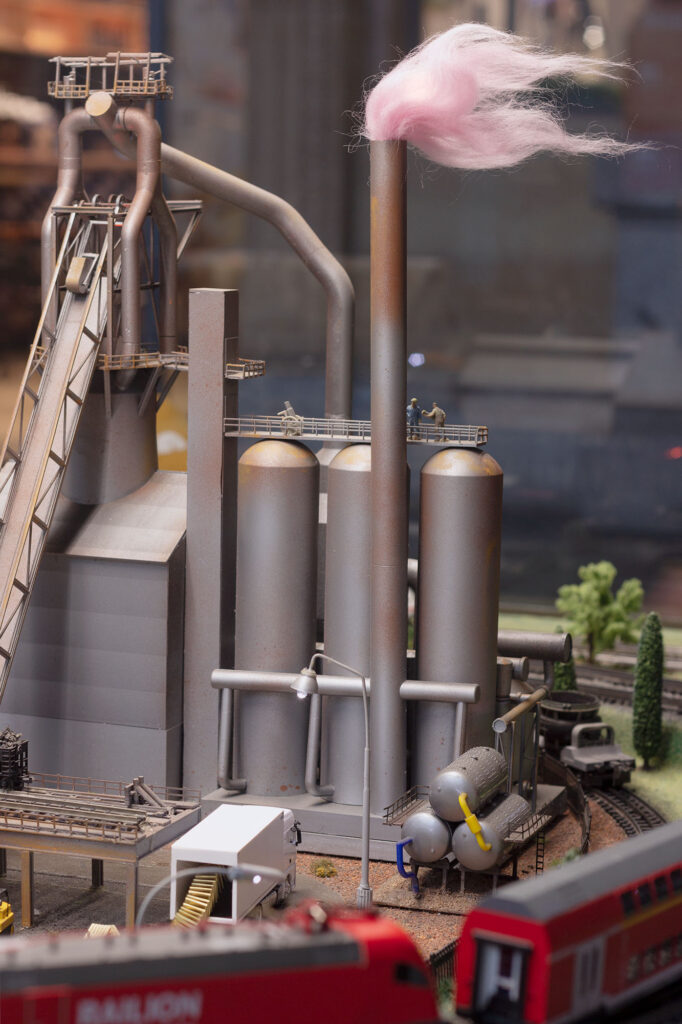
Pipe Dreams, 2024
Watte
Die Modelllandschaft erzählt Gegenwart wie im Bilderbuch. Die Miniaturwelt setzt sich zusammen aus stereotypen Merkmalen urbaner und ländlicher Räume: Gründerzeitliche Wohnhäuser und Büroturm, Feuerwache und Hubschrauberlandeplatz, Supermarkt und Bahnhof, Landgasthof, Angelteich und Jägerzaun. Es gibt auch ein Industriegebiet mit Kohleabbau, Kraftwerk und Windkraftanlage. Alles ist so überschaubar! In dieser Vereinfachung von Welterfahrung und Reduktion von Komplexität steckt eine Romantik, die einen ungewöhnlichen Widerhall findet: Rosafarbener Rauch steigt aus den Schornsteinen der Fabrik auf und verwandelt die Abgase in zuckerwatteartige Wolkengebilde. Mit dieser beiläufigen Intervention verwischt das Künstlerinnen-Duo FORT auf eine poetische Weise die Grenzen von Fiktion und Realität noch ein kleines Stückchen mehr.
Pipe Dreams, 2024
Cotton wool
The model landscape tells a picture-book story of the present. The miniature world is made up of stereotypical features of urban and rural areas: Wilhelminian-style apartment buildings and an office tower, a fire station and a helipad, a supermarket and a train station, the country inn, a fishing pond and a hunter’s fence. There is also an industrial area with coal mining, a power station and a wind turbine. Everything is so manageable! There is a romanticism in this simplification of world experience and reduction of complexity that has an unusual resonance: Pink smoke rises from the factory’s chimneys, transforming the exhaust fumes into cotton candy-like cloud formations. With this subtle intervention, the artist duo FORT poetically blurs the lines between fiction and reality just that little bit more.
03
Jack Cheetham
Go to Bio
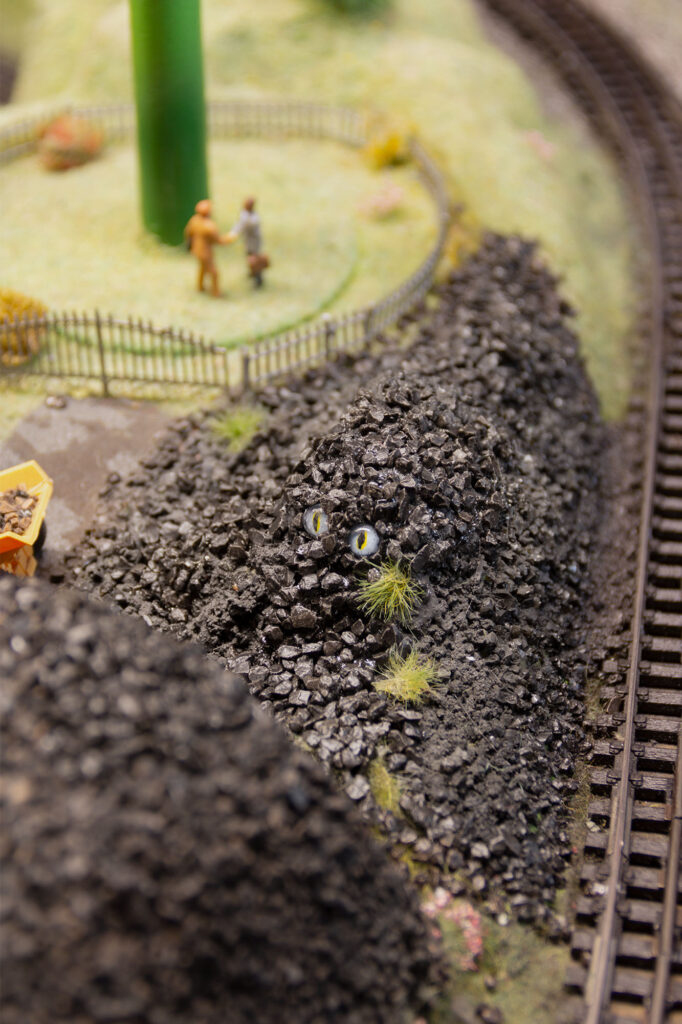

Material, 2024
Glasaugen, Acryl, Stein
Pig Boots (for a lost puppet), 2024
Polyurethan, Gips, Acryl
Jack Cheethams Installationen bewegen sich zwischen den Welten. Die objekthaften Charaktere und interaktiven Skulpturen eröffnen einen Kosmos semi-fiktionaler Erzählungen, aus denen sich alternative Realitäten fantasieren und spekulative Zukünfte erträumen lassen. Am Rande der Industrieanlage erweckt die Installation Material zwei in die Miniaturlandschaft integrierte Kohlehaufen zum Leben. Mit detailverliebten, handbemalten Glasaugen versehen, stehen sich die anthropomorphen Wesen gegenüber und tauschen Blicke aus. Das Potenzial eines imaginierten Dialogs zwischen den beiden Kreaturen trägt die künstlerische Arbeit aus der Miniaturwelt heraus und hinein in die Köpfe der Betrachter:innen.
Versteckt in Unterführungen, hinter Brückenpfeilern und Bäumen lässt sich bei genauem Hinsehen die zweiteilige Arbeit Pig Boots (for a lost puppet) erhaschen. Die Skulpturen im Miniaturformat tarnen sich zunächst in ihrer Umgebung. Auf den zweiten Blick transformieren sich die überlebensgroßen Felsbrocken zu einem zurückgelassenen Paar abgetragener Stiefel; auf den dritten Blick offenbart sich ihre tierische Gestalt.
Material, 2024
Glass eyes, acrylic, stone
Pig Boots (for a lost puppet), 2024
Polyurethane, plaster, acrylic
Jack Cheetham’s installations move between worlds. The object-like characters and interactive sculptures open up a cosmos of semi-fictional narratives from which alternative realities can be fantasised and speculative futures dreamt up. At the edge of the industrial plant, the installation Material brings to life two piles of coal integrated into the miniature landscape. With their detailed, hand-painted glass eyes, the anthropomorphic creatures face each other and exchange glances. The potential of an imagined dialogue between the two creatures carries the artistic work out of the miniature world and into the minds of the viewers.
Hidden in tunnels, behind bridge pillars and trees, the two-part work Pig Boots (for a lost puppet) can be caught on closer inspection. The miniature sculptures initially camouflage themselves in their surroundings. At second glance, the larger-than-life boulders are transformed into a pair of worn boots that have been left behind; at third glance, their animalistic form is revealed.
04
Bianca Pedrina
Go to Bio
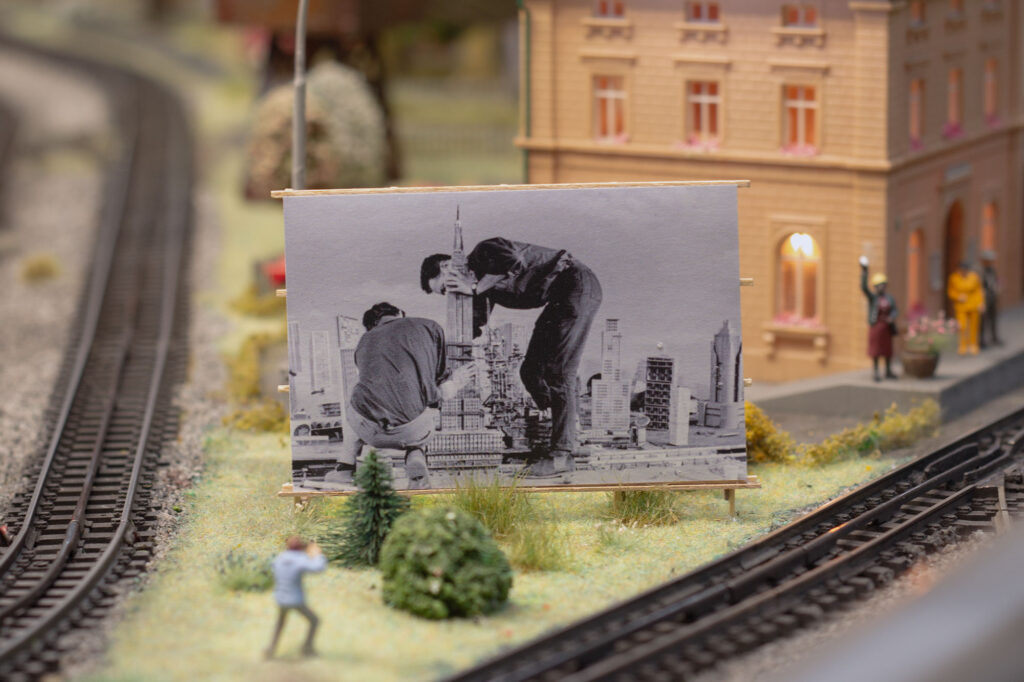
The world at our feet, 2024
UV-Direktdruck auf Affichenpapier, Karton, Holz, Metall
Drei historische Schwarz-Weiß-Aufnahmen zeigen Personen bei der Betrachtung von Gebäuden und Szenerien im Miniaturformat oder bei der Arbeit an Architekturmodellen und Filmsets. Montiert sind die Motive auf verschiedenen Displays, die Großplakatflächen nachempfunden sind und als freistehende Elemente installiert oder an Wänden befestigt wurden.
Die Arbeit knüpft an eine Recherche zu Fotografien an, die berühmte Architekten zusammen mit ihren Architekturmodellen zeigen, die Pedrina erstmals im Künstlerbuch Models veröffentlichte. Im Zentrum steht dabei die Inszenierung des zumeist männlichen Architekten als gottähnlichen Schöpfer von gesellschaftlichen, in Architektur gegossenen Utopien oder als Erschaffer fiktionaler Welten, die zur Bühne für filmische Illusionen werden.
The world at our feet befragt das (Größen)Verhältnis der menschlichen Körper zum Modell, die Machtkonzentration, die mit der Rolle der Architekt:in verbunden ist, und führt die Erschaffer:innen dieser Welten als Miniaturen selbst in eine solche ein.
The world at our feet, 2024
UV direct print on affiche paper, cardboard, wood, metal
Three historical black and white photographs show people looking at buildings and scenery in miniature format or working on architectural models and film sets. The motifs are mounted on various displays that are modeled on large billboards and installed as free-standing elements or attached to walls.
The work follows on from research into photographs showing famous architects together with their architectural models, which Pedrina first published in the artist’s book „Models“. The focus here is on the staging of the mostly male architect as the god-like creator of social utopias cast in architecture or as the creator of fictional worlds that become the stage for cinematic illusions.
The world at our feet questions the (size) ratio of the human body to the model, the concentration of power associated with the role of the architect, and introduces the creators of these worlds as miniatures themselves.
05
Tim Etchells
Go to Bio
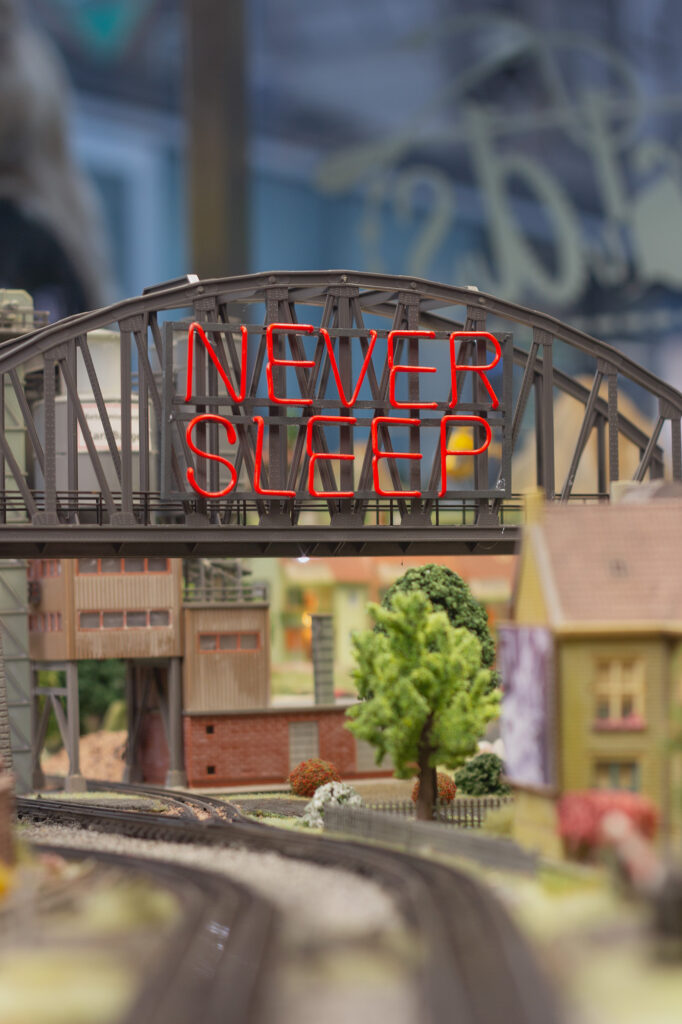
Never Sleep, 2015 / 2024
Modell Neon Schriftzug
Draht, Sprühfarbe
Wer schläft, produziert und konsumiert nicht. Die Ideologie ständiger Verfügbarkeit und dauerhafter Erreichbarkeit zeitgenössischer, kapitalischer Gesellschaften erheben Schlaflosigkeit zur Tugend. In großen, roten Lettern prangt der Imperativ Never Sleep (2015) an den Streben der Eisenbahnbrücke über der Stadt. Es ist eine unmögliche Handlungsanweisung, die gleichzeitig dazu auffordert, immer wachsam zu bleiben, sich nicht zu entspannen und stets auf der Hut zu sein. Im Kontext der dauerhaft ausgeleuchteten, stillstehenden Miniaturlandschaft, die wie eine Art Scheinwelt am immer in Bewegung begriffenen Nicht-Ort des Hauptbahnhofs steht, sorgt dieser doppelbödige Ausspruch für gezielte Verwirrung.
Tim Etchells Neon-Schriftzüge greifen die Vieldeutigkeit, Lebendigkeit und Fragilität von Sprache auf und übertragen sie in paradoxe Botschaften und Sprachbilder, die uns aufmerksam werden lassen.
Never Sleep, 2015 / 2024
model neon sign
wire, spray paint
Those who sleep neither produce nor consume. The ideology of constant availability and permanent accessibility of contemporary, capitalist societies elevates sleeplessness to a virtue. The imperative Never Sleep (2015) is emblazoned in large red letters on the struts of the railway bridge above the city. It is an impossible instruction that simultaneously calls on us to remain vigilant, never relax and always be on our guard. In the context of the permanently illuminated, stationary miniature landscape, which stands like a illusory world in the constantly moving non-place of the main railway station, this ambiguous statement causes deliberate confusion.
Tim Etchell’s neon lettering picks up on the ambiguity, liveliness and fragility of language and translates it into paradoxical messages and linguistic images that keep us on our toes.
06
Jacqueline Kiyomi Gork
Go to Bio
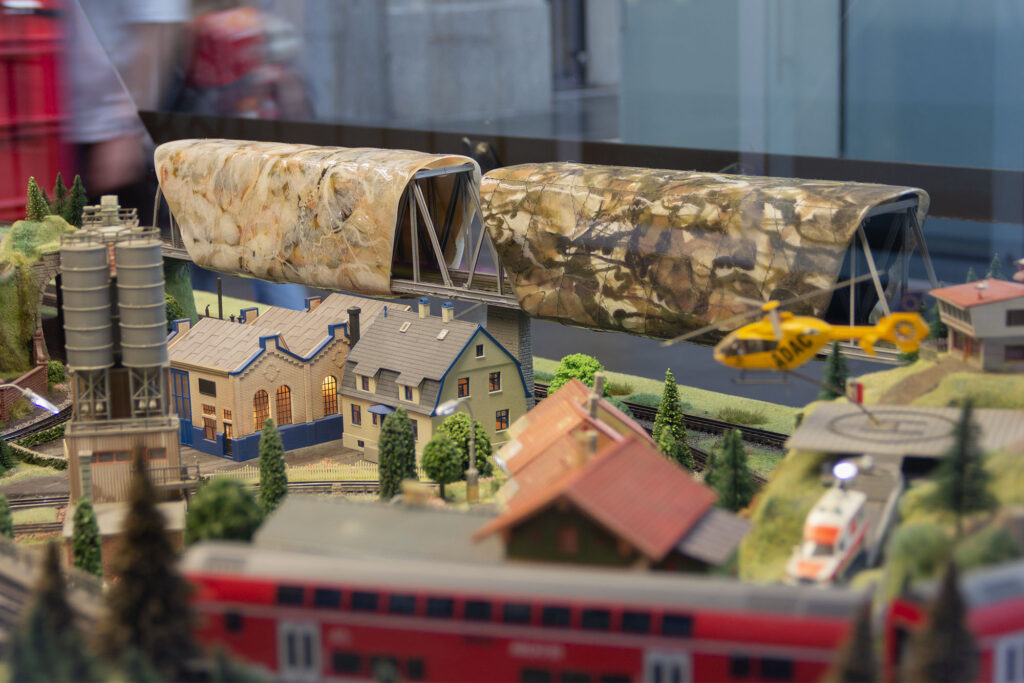
Noise blanket no. 50, 2024
Silikon, Leinwand, Polypropylenfasern
Noise blanket no. 51, 2024
Silikon, Leinwand, Polypropylenfasern
Jacqueline Kiyomi Gork hat Lärmschutzverkleidungen für die Schnellzugbrücke der Miniaturwelt entworfen. Die flexibel installierbaren Module aus Silikon lassen die Brücke durch ihre die Umgebung referenzierende Farbgebung in der Landschaft aufgehen. Gork wendet sich damit Fragen nach der realistischen Darstellung von infrastrukturellen Problemen in urbanen Räumen, speziell der Lärmbelästigung durch Zugstrecken oder Autobahnen, zu, deren akustische Konsequenzen in den wenigsten Modelllandschaften ästhetisch mitgedacht werden. Diese ‘Logikfehler’ fallen den wenigsten Betrachter:innen auf den ersten Blick auf, täuscht doch der oftmals nostalgisch verklärte, detaillierte Gesamteindruck darüber hinweg, doch müssen sie für die Miniaturbewohner:innen fatale Folgen haben.
Von außen betrachtet bietet die Arbeit eine zweite Lesart an: Die dämmenden Elemente verschlucken den Sound der vorbeifahrenden Züge, wodurch ein dem Anordnungsmuster entsprechender Rhythmus entsteht, der für die Besucher:innen von außen hörbar wird.
Noise blanket no. 50, 2024
Silicon, canvas, polyfiber
Noise blanket no. 51, 2024
Silicon, canvas, polyfiber
Jacqueline Kiyomi Gork has designed noise protection cladding for the express train bridge in miniature world. The flexibly installable silicone modules allow the bridge to blend into the surrounding landscape thanks to their color scheme that references their surroundings. Gork thus addresses questions about the realistic representation of infrastructural problems in urban spaces, especially noise pollution from train lines or motorways, the acoustic consequences of which are aesthetically considered in very few model landscapes. Very few viewers notice these ‚logical errors‘ at first glance, as the often nostalgically transfigured and detailed overall impression is deceptive, but they must have fatal consequences for the miniature inhabitants.
Viewed from the outside, the work offers a second interpretation: The muffling elements swallow up the sound of passing trains, creating a rhythm corresponding to the arrangement pattern that is audible to visitors from outside.
07
Johannes Moeller
Go to Bio
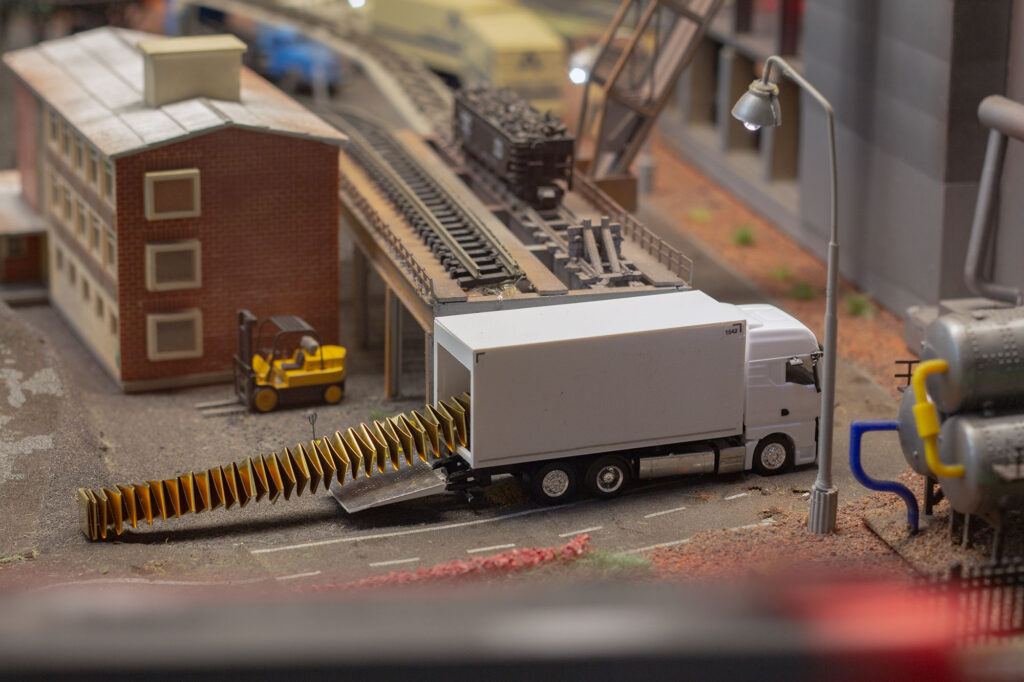
Column, 2024
Miniatur eines Speditions-LKW, Messing
Oft zielt die Inszenierung eines Kunstwerks darauf ab, dass es mit seiner Umgebung harmoniert oder einen bewussten Kontrast erzeugt – und auf jeden Fall so wirkt, als gehöre es ganz selbstverständlich an diesen Platz. Aber wie ist es eigentlich an diesen Ort gekommen? Wie gelangt die Kunst aus dem Atelier in eine Ausstellung oder in den öffentlichen Raum? Das Transportmanagement bleibt dem Publikum in der Regel verborgen, ja, es wird geradezu versteckt. Als würde das Wissen um diese profane Seite die Betrachtung der Kunst stören und ihrer Illusionskraft Abbruch tun.
Mit Column kreiert Johannes Moeller eine Situation, die scheinbar einen Blick hinter diese Kulissen erlaubt: Aus der geöffneten Laderampe eines weißen LKWs ragt die Fracht heraus: eine aus Messingband gefaltete Hexentreppe, die in ihrer Formwiederholung an Skulpturen der Moderne erinnert. Das Objekt ist jedoch viel länger als der Laderaum selbst – eigentlich unmöglich, dass es so transportiert wurde. So wird das Speditionsauto zum Podest der Kunst, zum Symbol einer anderen Form der Arbeit, die der künstlerischen Praxis entgegensteht, und suggeriert eine Bewegung im Kontrast zur Stasis der Skulptur.
Column, 2024
Miniature of a haulage lorry, brass
The staging of a work of art is often aimed at harmonising it with its surroundings or creating a conscious contrast – and in any case making it appear as if it naturally belongs in this place. But how did it actually get there? How does the art get from the studio to an exhibition or public space? The transport management usually remains hidden from the public, indeed, it is almost concealed. As if the knowledge of this profane aspect would interfere with the viewing of the art and detract from its illusionary power.
With Column, Johannes Moeller creates a situation that seemingly allows a glimpse behind the scenes: the freight protrudes from the open loading ramp of a white lorry: a ‘origami spring’ folded out of brass strips, whose repetition of form is reminiscent of modernist sculptures. However, the object is much longer than the loading space itself – it is actually impossible that it was transported in this way. The lorry thus becomes a pedestal for the artwork, a symbol of a different form of work that contrasts with artistic practice and suggests movement in contrast to the stasis of the sculpture.
08
Shirin Sabahi
Go to Bio
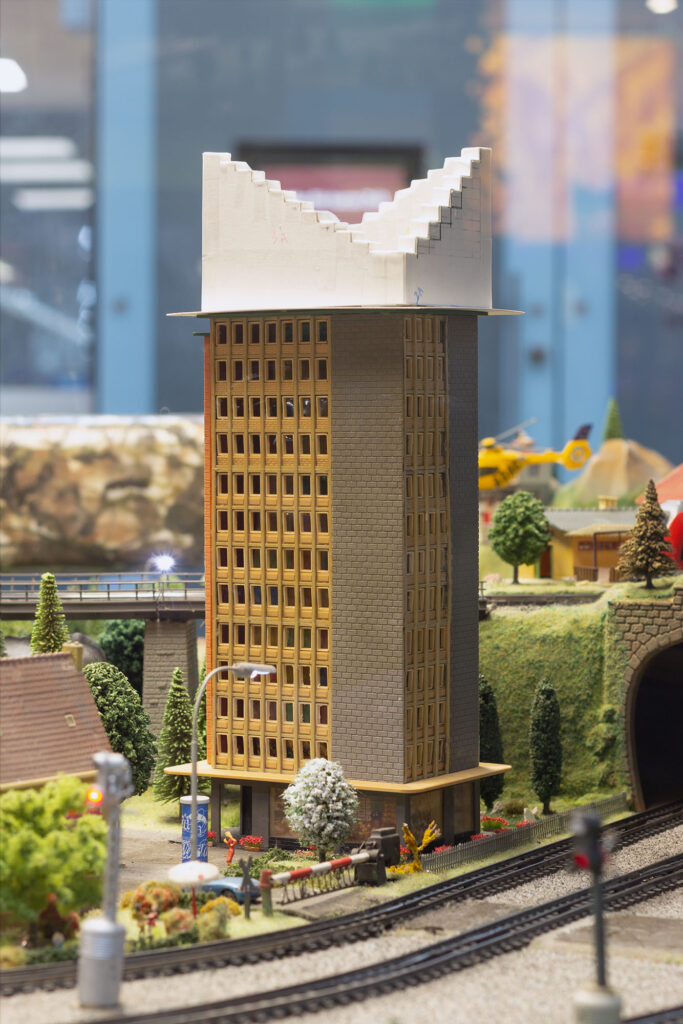
Penrose Steps, 2024
Karton, Graphit, Farbstift, Klebeband
Ein einziges Hochhaus überragt die pittoreske Miniaturstadt. Mit zentraler Lage und dem Versprechen auf eine gute Aussicht verkörpert der “Faller-Turm” ein vorstellbares Pendant zu hochpreisigen Investment-Penthäusern in Metropolregionen. Am gegenwärtig verknappten Immobilienmarkt führt die Frage nach Wohnraum und architektonischen Bestand nur vereinzelt zu einem Denken in die Höhe.
Für ihre Serie Plinth (2021) lud Shirin Sabahi Künstler:innen ein, Dachaufbauten für akkurat gefertigte Gebäudesockel zu imaginieren und die neutralen Modelle skulptural aufzustocken. Penrose Steps ist Sabahis eigene künstlerische Reaktion auf die Tendenzen urbaner Stadtentwicklung und verhandelt das komplexe Verhältnis von Oben und Unten. Frei von ökonomischem Denken setzt sich die unmögliche Figur wie ein Hut auf das Hausdach. Angelehnt an die Überlegungen der britischen Mathematiker Penrose bewegt sich der skulpturale Eingriff zwischen Architektur und Wahrnehmungsverzerrung. Als dreidimensionale Treppe, die in sich selbst zurückläuft, erzeugt sie die optische Illusion von Unendlichkeit und ist zugleich physikalisch unbezwingbar.
Penrose Steps, 2024
cardboard, graphite, colored pencil, Scotch tape
A single high-rise building towers above the picturesque miniature town. With its central location and the promise of a good view, the „Faller Tower“ embodies a conceivable counterpart to high-priced investment penthouses in metropolitan regions. In the currently scarce real estate market, the question of living space and architectural stock only occasionally leads to thinking upwards.
For her series Plinth (2021), Shirin Sabahi invited artists to imagine roof superstructures for meticulously crafted building-like plinths and to sculpturally raise the neutral models. Penrose Steps is Sabahi’s own artistic reaction to the trends of urban development and negotiates the complex relationship between above and below. Free from economic thinking, the impossible figure sits on the roof of the building like a hat. Based on the ideas of the British mathematician Penrose, the sculptural intervention moves between architecture and distortion of perception. As a three-dimensional staircase that runs back into itself, it creates the optical illusion of infinity and is at the same time physically unconquerable.
09
Total Refusal
Go to Bio
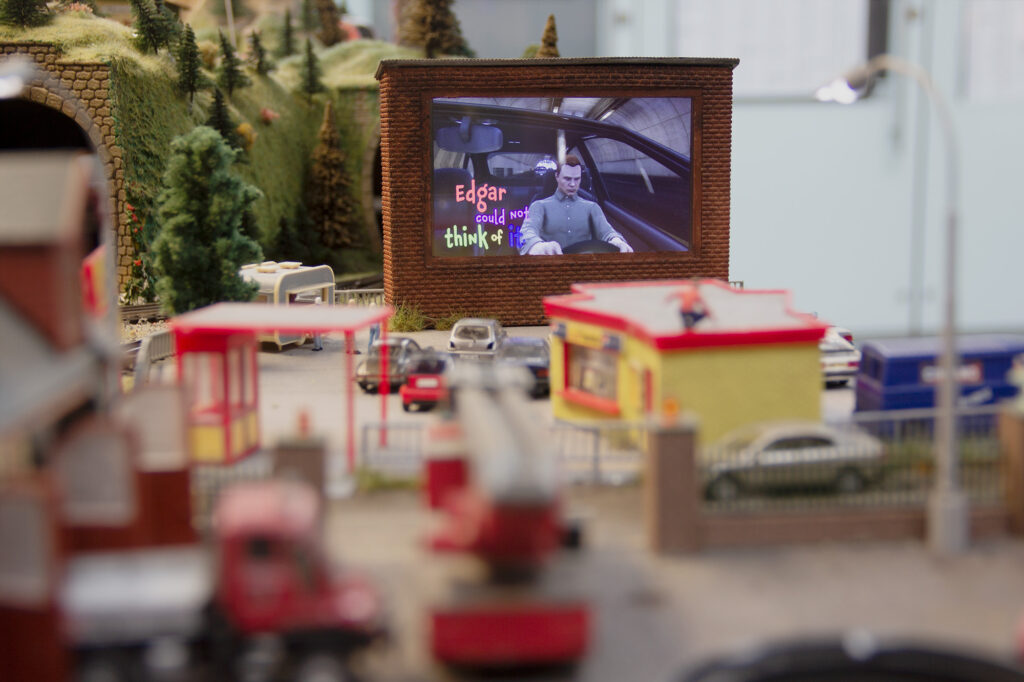
Kinderfilm, 2023
Video, 11:35 Min.
Die sogenannten Machinimas, auf populären Computerspielen basierende Kurzfilme, sind seit 2018 zum Markenzeichen Total Refusals geworden, die sich selbst als ‘pseudo-marxistische Medienguerilla’ bezeichnen. Ausgangspunkt der Filme des Kollektivs ist die kritische Analyse dieser virtuellen Welten – so auch in Kinderfilm: Es ist ein ganz gewöhnlicher Tag im Videospiel “Grand Theft Auto V”. Die Straßen sind voller Autos; Menschen folgen, wie auf Schienen, ihren täglichen Routinen, veranstalten ein Barbecue im Garten oder liegen am Strand in der Sonne. Und doch ist die Spielwelt durch eine Abwesenheit gekennzeichnet, die schwerwiegende Folgen hat – eine fehlende Jugend, die als vorbeugende Schutzmaßnahme vor Gewaltfantasien ausgespart wurde. Unfähig diese Leere zu begreifen, ist der Protagonist Edgar der Frage auf der Spur, was denn wohl in den Algorithmen seiner Lebenswelt fehlt. Während er den Betrachter:innen die Unheimlichkeit seiner Normalität zeigt, entdeckt Edgar eine schöne und gleichsam albtraumhafte Welt neu.
Kinderfilm, 2023
Video, 11:35 min.
Since 2018, so-called machinimas, short films based on popular computer games, have become the trademark of Total Refusal, which describes itself as a ‚pseudo-Marxist media guerrilla‘. The starting point of the collective’s films is the critical analysis of these virtual worlds – as in Kinderfilm: It’s just another day in the video game Grand Theft Auto V. The streets are full of cars; people follow their daily routines as if on rails, having a barbecue in the garden or lying in the sun on the beach. And yet the game world is characterized by an absence that has serious consequences – a lack of youth that has been left out as a preventative protective measure against fantasies of violence. Unable to comprehend this emptiness, the protagonist Edgar is on the trail of the question of what is missing in the algorithms of his lifeworld. While he shows the viewer the uncanniness of his normality, Edgar rediscovers a beautiful and, as it were, nightmarish world.
10
Maje Mellin
Go to Bio
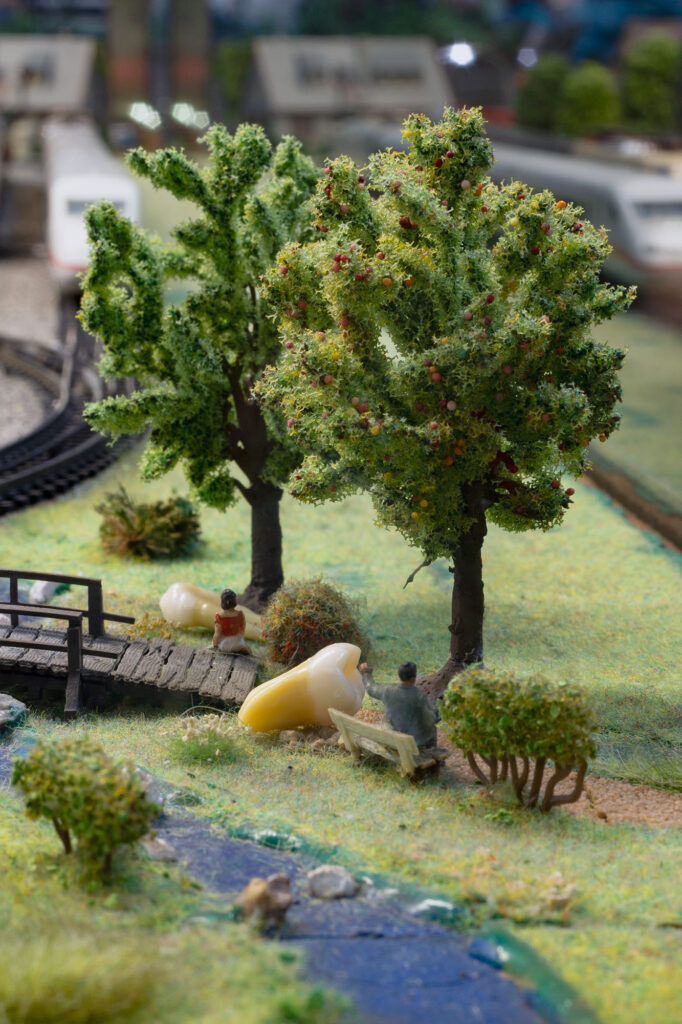
Destiny’s Teeth, 2024
Kunstharz
In der Landschaft der Miniaturwelt verstreut liegen eine Reihe Zähne. Es scheint, als seien sie einer Person beim Betrachten der Szenerie aus dem Mund gefallen und als menschliche Artefakte in die Landschaft eingegangen. Dieses surreale Bild löst Unbehagen aus. Nicht nur in der Traumdeutung wird der Verlust von Zähnen als ein Kontrollverlust interpretiert – auch ganz real bedeutet er eine erhebliche Einschränkung von Lebensqualität. Mit den Zähnen zerkleinern wir unser Essen und formen unsere Sprache. Es steckt also eine Menge Autonomie in einem intakten Gebiss. Die Zähne selbst können aber auch jenseits unserer Körper existieren. Als Überbleibsel menschlicher Existenz, von ihrer ursprünglichen Funktion befreit, überdauern sie bis zu Jahrtausenden. Der Körper, von dem sie einst Teil waren, ist dann schon längst vergangen.
Für das objet trouvé Destiny’s Teeth nutzt Maje Mellin maßstabsgetreue Modellzähne aus der Zahnmedizin. Ihre Präsenz bricht mit der Illusion der Miniaturlandschaft und führt den menschlichen Körper in seiner Fragmentierung und Vergänglichkeit als Maßstab in diese ein.
Destiny’s Teeth, 2024
Resin
A number of teeth are scattered across the landscape of the miniature world. It seems as if they have fallen out of a person’s mouth while looking at the scenery and have become part of the landscape as human artifacts. This surreal image triggers unease. It is not only in dream interpretation that the loss of teeth is interpreted as a loss of control – in reality, it also means a considerable reduction in quality of life. We use our teeth to grind our food and shape our speech. So there is a lot of autonomy in an intact set of teeth. However, the teeth themselves can also exist beyond our bodies. As remnants of human existence, freed from their original function, they can survive for thousands of years. The body of which they were once a part is long gone by then.
For the objet trouvé Destiny’s Teeth, Maje Mellin uses true-to-scale model teeth from dentistry. Their presence breaks with the illusion of the miniature landscape and introduces the human body in its fragmentation and transience as a scale into it.
11
Genevieve Goffman
Go to Bio

Men, 2024
3D-Druck, Kunststoff
Men ist eine Arbeit, die die Künstlerin speziell für den Kontext dieser Ausstellung entwickelt hat. Der 3D-Druck zeigt zwei humanoide Figuren in Overalls, deren Köpfe jeweils an den eines Hundes und den einer Ratte erinnern. Beide scheinen ein kunstvolles, mit Ornamenten verziertes Objekt bewegen zu wollen, das mit einem Haken an einem Lastenkran befestigt ist. Die Gruppe fügt sich fast unauffällig in das zentrale Fabrik-Sujet der Miniaturlandschaft ein. Nur die leichte Verschiebung im Maßstab und das bewusst gewählte steril-weiße Material der Figuren verdeutlichen die Absurdität der Szene. Während Genevieve Goffman die Ästhetik des Genres Fantasy fetischisiert, ist dabei die Beleuchtung des komplexen Verhältnisses von Fantasie, Geschichte und Technik ihr eigentliches Anliegen. Indem Goffman ein wertvolles Artefakt anstelle von Kohlesäcken an der Kranvorrichtung anbringt, macht sie die Geschichte des verhängnisvollen Verhältnisses von der Erfindung der Dampfmaschine und menschlichen Gier auf, die einen eurozentrischen Imperialismus begünstigten, der globale Auswirkungen nach sich zog.
Men, 2024
3D print, plastic
Men is a work that the artist developed especially for the context of this exhibition. The 3D print shows two humanoid figures in overalls, whose heads resemble those of a dog and a rat respectively. Both seem to want to move an ornate object decorated with ornaments, which is attached to a crane with a hook. The group blends almost unobtrusively into the central factory subject of the miniature landscape. Only the slight shift in scale and the deliberately chosen sterile white material of the figures emphasize the absurdity of the scene. While Genevieve Goffman fetishizes the aesthetics of the fantasy genre, her real concern is to illuminate the complex relationship between fantasy, history and technology. By attaching a valuable artifact to the crane device instead of coal sacks, Goffman reveals the history of the disastrous relationship between the invention of the steam engine and human greed, which fostered a Eurocentric imperialism that had global repercussions.
12
Béla Feldberg
Go to Bio
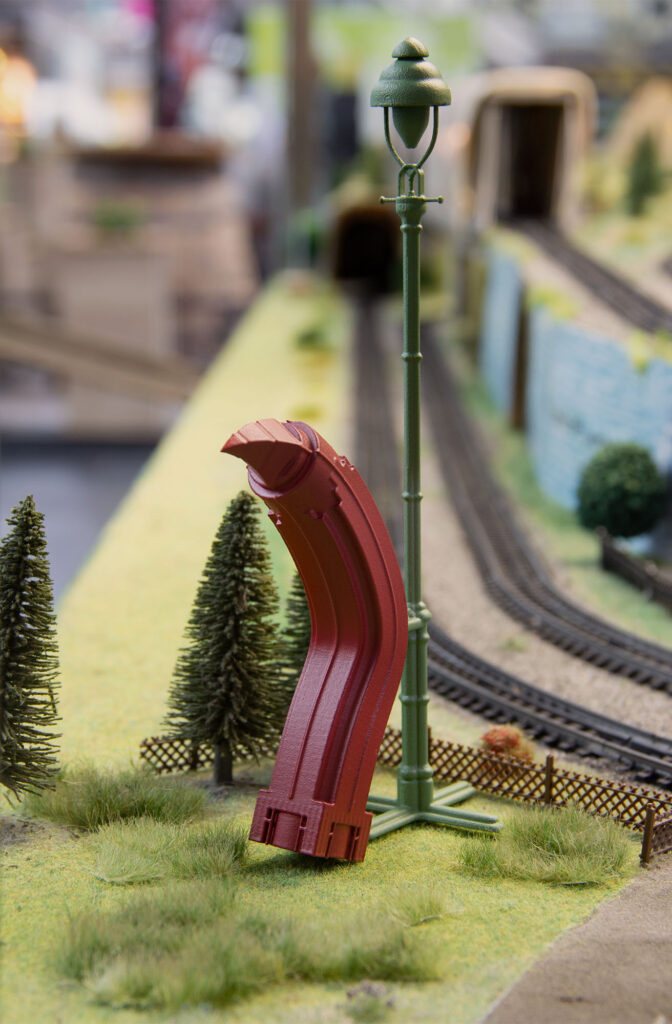
Messeturm, 2024
3D-Druck, Kunststoff
Béla Feldberg fügt ein Stück lokaler Baugeschichte in die Miniaturlandschaft ein.
Seine Skulptur ist vom Frankfurter Messeturm inspiriert, der bei seiner Fertigstellung 1991 als höchstes Gebäude in der EU galt und für viele ein Wahrzeichen des Siegs des Kapitals gegenüber Bürger:inneninteressen ist. Noch in den 1970ern kämpften Anwohner:innen im „Frankfurter Häuserkampf“ erfolglos um den Erhalt von Wohnraum im Westend, der letztlich zugunsten der Schaffung von Bürobauten von der Stadtpolitik aufgegeben wurde. Bei Feldberg scheint sich der Turm wie im Nachbeben des Protests zu winden und verliert dabei seine phallische Bleistiftform.
Inspiriert ist die Arbeit auch von den Zeichnungen Madelon Vriesendorps, einer der Gründer:innen des Office of Metropolitan Architecture, das für seine avantgardistischen Entwürfe bekannt ist. In ihren Zeichnungen und Grafiken werden Wolkenkratzer zu flexiblen, menschenähnlichen Gestalten, die gemütlich im Bett liegen oder sich über eine Kuchentafel beugen.
Messeturm, 2024
3D print, plastic
Béla Feldberg inserts a piece of local architectural history into the miniature landscape. His sculpture is inspired by Frankfurt’s Messeturm, which was considered the tallest building in the EU when it was built in 1991 and for many is a symbol of the victory of capital over citizens‘ interests. Back in the 1970s, residents fought unsuccessfully in the „Frankfurt housing struggle“ to preserve housing in Frankfurt’s Westend, which was ultimately abandoned by city politicians in favor of creating office buildings. In Feldberg’s work, the tower seems to bend as if in the aftershock of protest, losing its phallic pencil shape in the process.
The work is also inspired by the drawings of Madelon Vriesendorp, one of the founders of the Office of Metropolitan Architecture, which is known for its avant-garde designs. In her drawings and graphics, skyscrapers become flexible, human-like figures lying comfortably in bed or bent over a cake table.

